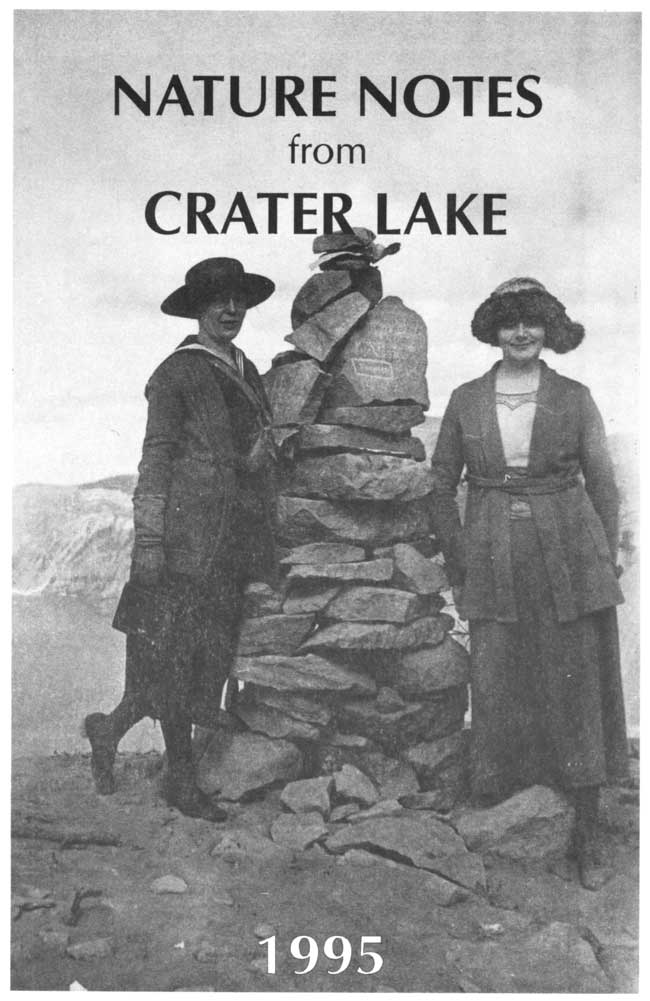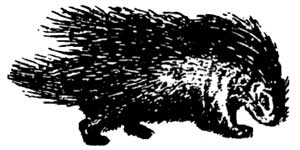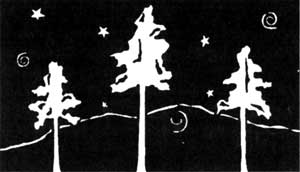Volume 26, 1995
All material courtesy of the National Park Service. These publications can also be found at http://npshistory.com/
Nature Notes is produced by the National Park Service. © 1995
Cover Photo: Two visitors atop Garfield Peak, ca. 1920. Courtesy Mrs. Cole Brown.
Introduction
Present and former park employees have again volunteered their efforts in bringing this volume of Nature Notes to fruition. In addition to thanking the authors, I would like to take this opportunity to acknowledge/he efforts of Susan Marvin and Judy Giles in greatly facilitating the editorial process. Intended as an aid to visitors at Crater Lake National Park and Oregon Caves National Monument, this publication contains original research or observations that should be of interest to anyone wanting more than a fleeting glimpse of either park area. Our hope is, of course, to provide some insights about the character and features of both places.
Since the Crater Lake Lodge reopens this year, I thought it appropriate to begin with an article that relates the hotel to its surroundings. This is followed by an eclectic mix of topics such as porcupines, ponds, and the Pacific Crest Trail which may entice park visitors to get away from their automobiles in favor of going further afield. Toward this end we encourage reprinting submissions that appear in Nature Notes from Crater Lake, as long as credit is given to authors and the Crater Lake Natural History Association.
Established in 1942, the Crater Lake Natural History Association’s purpose is to aid the National Park Service in its educational and resource management programs at Crater Lake National Park and Oregon Caves National Monument. It therefore sponsors this edition of Nature Notes as well as a number of other publications, research grants, and events. The association operates three sales outlets, with two located in Crater Lake National Park and another at the Illinois Valley Visitor Center in Cave Junction, Oregon. Proceeds from sales items are used entirely to support the association’s goals. A list of items available for sale can be obtained by writing to CLNHA’s Executive Director, P.O. Box 157, Crater Lake OR 97604, or by calling (541)594-2211 ext. 499.
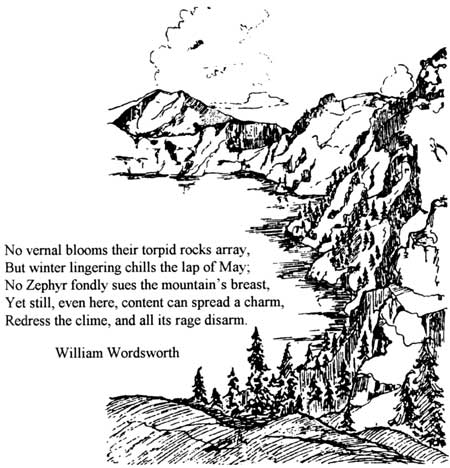
Ernest G. Moll, Blue Interval, Portland: Metropolitan Press, 1935, p. 6. Illustration by Karl J. Belser.
No vernal blooms their torpid rocks array,
But winter lingering chills the lap of May;
No Zephyr fondly sues the mountain’s breast,
Yet still, even here, content can spread a charm,
Redress the clime, and all its rage disarm.William Wordsworth
A Naturalist’s View of Crater Lake Lodge
The Crater Lake Lodge will reopen in the spring of 1995 after four years of rehabilitation work. There are just 71 guest rooms in the lodge, but all park visitors are welcome to spend some time in the building. They can relax in the Great Hall, have a meal in the dining room, examine a small exhibit room that centers on the lodge’s history, or wander around the grounds to contemplate Crater Lake and its surroundings. As you might expect, there are many opportunities for observation and study.
Landscaping adjacent to the lodge is a lesser-known component of a more than $15 million rehabilitation project. A separate landscape contract has been let in order to restore lodge grounds impacted during four summers of construction. In addition to historic and aesthetic criteria, the landscape plan addresses erosion and species integrity as two other areas of emphasis.
The effects of erosion can be seen just below the caldera rim. Roots of mature trees are exposed where the soil in which they grew has been worn away. Small-scale erosion in areas disturbed during construction and in newly planted beds is being checked by an erosion control blanket. This consists of wood shavings and a nylon net that will degrade in a few years with exposure to ultraviolet light. Concerns that the net might entangle deer have been alleviated upon observations that the animals traverse the blanket without difficulty.
The genetic integrity of plants placed around the lodge became a prime concern of consulting botanists. They insisted that vegetation planted in the restored landscape be limited to the floral gene pool of Crater Lake National Park. This would insure better adaptation for survival in the harsh environment (deep snows, long winters, dry summers, high elevation) of Rim Village, but also might prevent introduction of non-native species or variants which eventually could compete with native plants. All of the plants used in this project have been propagated from seed collected in the park, or from local cuttings.
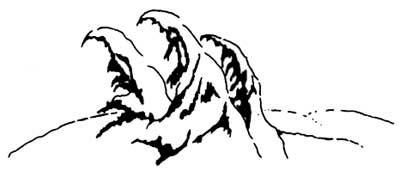
Young hemlocks curl over as snow accumulates.
Illustration by Amy Mark, National Park Service files.
All three tree species evident around the lodge are well adapted to the deep snows that fall at Crater Lake. Mountain hemlock, Tsuga mertensiana, with its distinctive droopy leader, is very flexible. Visitors in late fall or early spring might see young hemlocks curling over as snow accumulates, or slowly springing upright as the snow melts. Subalpine fir, Abies lasiocarpa, has also evolved to bend with heavy snow and strong wind. Mature trees display a distinctive spire-like silhouette, in part to shed snow and cut wind resistance. Whitebark pines, Pinus albicaulis, can be identified by clusters of five needles and very limber branches. They are often perched right at the caldera’s edge because their ecological niche permits survival in exposed areas where there is less competition from other species.
Contractors also transplanted a number of shrubs into beds around the lodge. Perhaps more than the trees, shrubs help blend the hotel with its surroundings because they can soften vertical lines imposed by building facades and provide transition between ground and structure. In utilizing a number of well adapted shrubs around the Crater Lake Lodge, this also provides a way to learn something about native plants.
Discovered only in 1896, the Crater Lake currant, Ribes erythrocarpum, is found in only a few areas outside park boundaries. This is a creeping shrub, and may form a large mat with copper-colored flowers in July and red berries in late summer. Waxy currant,Ribes cereum, by contrast, is more bushy and has smoother leaf edges. It can also be distinguished by white or pinkish flowers and yellowish red berries. Botanists found the waxy currant much easier to propagate from in-park sources than Crater Lake currant, perhaps because of its wide distribution at high elevation in dry, open places.
Pinemat manzanita, Arctostaphylos nevadensis, is a low, sprawling shrub that seldom grows more than a foot high. It has red bark on its slender stems, and evergreen, leathery leaves. This type of manzanita is also common along the Cleetwood Cove Trail leading down to the lake. It is one of several shrubs frequently browsed by deer.
Rubber rabbitbrush, Chrysothamnus nauseosus, is a relatively small shrub, being six inches to two feet in height. Its yellow flowers appear late in the summer and can be seen along the Garfield Peak Trail and at places like the Wineglass near the caldera’s edge.
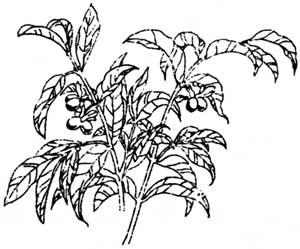 black twinberry L. Howard Crawford, Nature Notes from Crater Lake, Vol. 8, No. 3 (September 1935), p. 7. |
Sierra willow, Salix sitchensis, and Bush honeysuckle, Lonicera involucrata, both have long, large leaves, but they are easy to tell apart in the late summer. The willow, which ordinarily prefers wet habitats such as stream sides, develops seeds that give the appearance of small bits of cotton. Bush honeysuckle (which is sometimes called black twinberry) produces pairs of dark purple berries which are a favorite food of the Clark’s nutcracker, Nucrifraga columbiana. These berries can stain the bird’s beak bright purple, something which is often seen around Rim Village where this species of honeysuckle is common.
Botanists experienced difficulty in locating Mountain maple, Acer glabrum, from which cuttings could be obtained in the park. They eventually found several of these shrubs in a moist area near the east. As a result, several mountain maples can be seen near the southwest corner of the kitchen.
Mountain ash, Sorbus sitchensis, is fairly common around the lodge. Shrubs planted in the 1930s are about five feet tall, and in need of pruning. The leaves of mountain ash are composed of seven to eleven leaflets end have a shiny green color. This shrub produces red berries in the fall that are eaten by migrating cedar waxwings, Bombycilla cedrorum.
Although they are the smallest component of the landscape project, perennial wildflowers are, at times, its most colorful. Like the shrubs, these herbs provide an understory for trees and complement the grass-like native sedges. From midsummer until late fall, a number of perennial wildflowers transplanted into beds around the lodge may be seen.
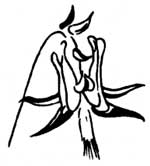 columbine Walter Rivers, Crater Lake Nature Notes, Vol. 14, No. 1 (1948), p. 11. |
As its name implies, the pearl-everlasting, Anaphalis margaritacea, has a long-lived flower. Its papery-white petals appear in July and last until snowfall. Growing from one to two feet tall, it is commonly seen along park roads where runoff creates moist conditions.
Visitors from the Rocky Mountains who are familiar with the pastel to deep blue of columbines in that region may be surprised to find the red and yellow Sitka columbine,Aquilegia formosa, around the lodge. This species of columbine is the only one in the park, but is common to forests along the Pacific slope. It is frequently seen during July and August in the Cascade Crest Wildflower Garden near Park Headquarters.
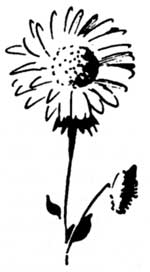 cascade aster Rivers, op. cit. |
Cascade aster, Aster ledophyllus var. covillei, has purple flowers with approximately eight radiating petals. This is the most common of the four asters in the park and was easily propagated from seed for transplanting at the lodge. It is often seen from July to September around the rim, usually in dry places.
Sulfur eriogonum, Erigonum umbellatum, is found in dry areas throughout the park and is sometimes known as wild buckwheat. This plant has small yellow flowers atop a leafless four to twelve inch stem. Its paddle-shaped, silver green leaves appear at the base. Another member of this genus, Eriogonum pyrolaefolium var. coryphaeum, is somewhat similar in appearance but has white flowers. E. pyrolaefolium is usually known as Dirty socks because of its objectionable odor.
Cliff penstamon, Penstamon rupicola, is an attractive woody plant with purplish pink flowers that grows in rock crevices. Often found on ledges along the Garfield Peak Trail, cliff penstamon has been planted in the rocks which help stabilize the rootball of a mountain hemlock transplanted at the east end of the lodge.
As intended, the trees, shrubs, and flowers around Crater Lake Lodge combine to help blend the building with its surroundings. Although they represent only a small part of the park’s flora, these species are also useful starting points in demonstrating how organisms adapt to exposed places at higher elevations. If nothing else, the plants adjacent to Crater Lake Lodge demonstrate that life can persist in an environment where natural succession is slow or even absent for long periods after disturbances occur.
Erik Hendrickson is a structural engineer with the National Park Service in Denver, Colorado. He helped direct the rehabilitation of Crater Lake Lodge.
Steve Mark is the park historian at Crater Lake. He has been editor of Nature Notes since its revival in 1992.
The Fretful Porcupine
Measuring up to 2.5 feet in length and weighing thirty pounds, the North American porcupine, Erethizon dorsatum, is one of the world’s largest rodents. Fossils of porcupine ancestors date back to the Oligocene epoch, about 30 million years ago. It is believed that porcupines originated in South America and are most closely related to the guinea pig and the chinchilla. While porcupines may not be considered great beauties of the natural world, they have proven themselves to be masters of survival. Naturalist Uldis Roze describes them as “a microcosm in the great evolutionary adventure of nature.”
Dark in color, they have a somewhat “frosted” appearance because their quills are yellow to white with a black tip. An average of 30,000 quills grow only on their backs, sides, and tails. These modified hairs have tiny scales like a fish, with each scale acting like a tiny barb on a fish hook. It is these scales that hold a quill tightly in a predator’s skin. Folklore describes a creature that is quick to fire quills at enemies. In truth, it slaps its victims with its tail only in self-defense and does not have the ability to project its quills, no matter how frightened. Muscle action combines with these scales to work the quills deeper and deeper into the unfortunate’s body, becoming very painful. If a vital organ is struck, they can be fatal. A misconception is that a quill will shrink if the end is cut off, making it easier to pull out. The quills are filled with a spongy material, not air, so they do not shrink or soften.
The range of porcupines covers most of the western United States. Their preferred habitat is dense forest, making Crater Lake National Park suitable for a healthy porcupine population. Slow and somewhat awkward, these nocturnal creatures are more graceful in trees than on the ground. They always climb up head first, but will back down a tree tail first. Much of their time is spent in a den which is usually a small cave or deep crevice in a ledge or rock pile, a large hollow in a tree trunk a hollow under a partially uprooted tree, or an abandoned animal burrow. In very cold weather or deep snow, porcupines sometimes stay in their dens for two to three days at a time. Solitary during most of the year, porcupines may band together to share a den and their communal heat. If a porcupine is seen out of its den in winter, it is most likely there to feed, then return to warmth. Possessing some of the poorest eyesight among all mammals, a typical porcupine can see only two to five feet in the distance. Poor vision is offset by excellent senses of smell and hearing. Porcupines vocalize; if disturbed, they may squeak, grumble, groan, or seem to mutter to themselves. They can also emit a high-pitched cry that people have mistaken for a bobcat or mountain lion.
Most often found between 5,000 and 6,500 feet in elevation, porcupines are strict vegetarians. Their favorite food is the inner bark of trees, though they tend to feed on young trees that would most likely be naturally shinned out. They also like leaves, certain grasses, berries, and fruits such as apples. They possess an insatiable love of salt, something which causes them to frequently loiter around highways which get salted during winter. This can lead to the death of many porcupines through being struck by vehicles. Porcupines are also drawn to objects that people have handled so as to lick the salty sweat left behind. Their search for sodium can thereby bring about the destruction of objects such as handrails, steps, and doorways.
Porcupines are somewhat different than most mammals in that the females stake out a territory and fight to protect it, rather than the males. A female porcupine has just one offspring per year and will raise it alone. Baby porcupines are called porcupettes and are comparatively large, being about one pound at birth. They are born with open eyes and soft quills, with the latter hardening within the first ten minutes after delivery. Porcupettes will travel long distances on their own almost immediately, but they do not climb trees for several months. The young porcupettes travel with their mother during night feeding sessions for three to four months when they become independent.
When thinking of the great animals of literature, seldom does the porcupine come to mind. The title of this article is taken from Act I, Scene V of Hamlet and reminds us that all creatures have a place in art, as well as science: “I could a tale unfold whose lightest word Would harrow up thy soul . . . Like quills upon the fretful porpentine { sic } . ” A naturalist must also exhibit duality, or lives in two worlds: the world of nature and the world of human ideas. One world is represented by a fallen tree; the other by a library. Each species studied, each theory formed brings the two worlds a bit closer together. We learn through the survivors and speculate on species that have become extinct. The porcupine thus becomes a storyteller of the woods. In its telling, its frets are fewer and its ancient story more eloquent.
Further Information
Uldis Roze, The North American Porcupine. Washington, DC: Smithsonian Institution Press, 1989.
Marianne Mills was the assistant chief of interpretation at Crater Lake until May 1995, when she transferred to Badlands National Park.
Mimicry Among the Pines?
The deep blue of Crater Lake is enhanced by the verdure of the coniferous forest around it. Splashes of green unite in harmony with multicolored volcanic bluffs in the caldera landscape. Distance masks the variety of species in these green areas. There is a certain pleasure in recognizing species by name, but even with a close view, walking among the noble conifers, there are striking similarities in the appearance of different members of a genus such as Abies, the true firs.
Sometimes these similarities obscure their differences. Such difficulty in distinguishing species is more challenging if seed cones are unavailable at the time identification is made. Since seed cones of the true firs disintegrate at maturity, features such as cone shape, cone scales, bracts, and seeds may not be available for inspection. This lack of essential diagnostic features can frustrate a desire to classify and distinguish a species by name.
Even when the important diagnostic features are present, species distinction may be confusing at times. In the late 1970s it was reported that Jeffrey pine, Pinus jeffreyi,occurs in the forested panhandle of Crater Lake National Park. The most northerly known natural populations of this tree occur, however, on serpentine substrates near the Illinois Valley southwest of Grants Pass. The biologists reporting Jeffrey pine in the panhandle (some 100 miles northeast of those Illinois Valley populations) based their determination primarily on seed cones which did not appear like cones of typical ponderosa pine, P. ponderosa. Apparently those biologists were unaware of another contender, P. washoensis, a rare pine similar to ponderosa but with smaller cones. As it turned out, the ponderosa variants in the panhandle are actually closer to Washoe pine than to Jeffrey pine based on cone length and diameter. There still is the need, however, for additional study of local populations as one part toward understanding variation on a larger geographic scale because the widely-distributed variants of ponderosa pine are so difficult to interpret.
If we shift our attention from three-needled pines to members of the genus whose needles are borne in clusters of five, each life zone (a concept which largely corresponds to elevation in this part of the Cascade Range) within Crater Lake National Park may be characterized by a different species. Sugar pine, P. lambertiana, of the mixed conifer forest bears foliage which resembles that of western white pine, P. monticola, which typically grows in association with more high elevation true firs such as red and noble fir within the A. magnifica/procera complex. When sugar pine and western white pine occur in overlapping habitats, younger trees of both species look alike. We can also find species very distinct taxonomically but adapted to similar habitats and displaying an amazing degree of similarity in a number of characteristics during each life stage. For example, whitebark pine, P. albicaulis, of the upper caldera rim area is strikingly similar to limber pine, P. flexilis. Although limber pine is absent at Crater Lake today, it typically occurs in subalpine habitats in the northern Rocky Mountains, much of the Great Basin, and the eastern Sierra Nevada, where there are some areas that whitebark and limber pine grow together. Strangely enough, limber pine is Oregon’s rarest conifer, with the state’s only known populations occurring in the Wallowa Mountains some 300 miles northeast of the park.
In asserting that many species look much alike, we may wonder what is a species? It is generally regarded as a group of similar individuals which are reproductively isolated from other groups. Although members of a species share many characteristics, variation is inherent. Hidden within the forest canopy are many seed cones nurturing potential trees. Formed through the genetic mystery of reproduction, the seeds bear an awesome responsibility in perpetuating their kind in all its variation. In conifers, the messenger of similarity and difference becomes the wind as it carries vast quantities of pollen to receptive young cones. Differences in timing of pollen release and of conelet receptivity act as barriers to cross-pollination between different species.
Recognition of species is not only rewarding, but also crucial to understanding interactions among trees, their physical environment, and the creatures that depend on the trees. Coevolution is the reciprocal evolution of two species, in that one species adapts to evolution in the other. If, for example, we have a specific insect and a plant on which it depends for food, an evolutionary change in the chemistry of the plant might make it less digestible by the insect species. Those individuals of the insect species which are still able to digest the plant tissues survive and reproduce. Thus the evolutionary change in the plant has led to an evolutionary change in the insect.
Sometimes coevolution or coadaptation results in mimicry. This is the close resemblance of one species to another, stemming from pressures acting to select for those individuals in the “mimicking” species which resemble the “mimicked” species. Mimicry may have various advantages to a species, including protection from predation, thereby favoring their survival. But is this the case in conifers? Pines are subject to predation by a multitude of herbivorous insects which, at least in some cases, identify pine species based on the unique chemistry of their resins. It is unknown at present if there are any cases where resins of one conifer species have, over time, come to include a certain compound or compounds which cause insects to avoid another species. This would happen through the chance occurrence of the compounds in individuals which would then be more likely to survive and reproduce.
In some cases, experts may be faced with perceived differences which do not justify separation into distinct species. This is the challenge facing the biosystematist in evaluating the degree of difference necessary to separate species. The classification of organisms necessarily includes some subjective evaluation because lumping all similar species into one group on some “objective” basis (thereby ignoring their interesting differences) would compromise our understanding of the species’ respective ecological roles and the limits of their environmental ranges. With the term “species diversity” becoming increasingly important in discourse about the biological conservation of organisms, it seems obvious that careful thinking and humility are needed when trying to assess ecological quandaries posed by forces difficult to quantify. Those who oversimplify and arrogantly generalize about our world do so at their peril, as Alexander Pope noted almost three centuries ago:
Go, wond ‘rous creature! mount where Science guides,
Go, measure earth, weigh air, and state the tides;
Instruct the planets in what orbs to run,
Correct old Time, and regulate the Sun;
Go, soar with Plato to th’ empyreal sphere,
To the first good, first perfect, and first fair;
Or tread the mazy round his follow ‘rs trod,
And quitting sense call imitating God;
As Eastern priests in giddy circles run,
And turn their heads to imitate the Sun.
Go, teach Eternal Wisdom how to rule –
Then drop into thyself, and be a fool!
Ron and Joy Mastrogiuseppe are former seasonal employees at Crater Lake. They are now based in Burns, Oregon, where he is an ecologist and she works as a botanist.
Pronghorn: Return of the Native

Shirley Briggs in Arthur S. Einarsen, The Pronghorn Antelope, Washington, DC: The Wildlife Management Institute, 1948, p. 1.
One of the reasons people come to national parks is to see large animals. The most ubiquitous large animals in North American national parks have been called ungulates. Although this classification for exclusively herbivorous mammals with horns or antlers is no longer used, three families comprise the order Artiodactyla, or hoofed mammals. Members of two families, Cervidae (deer and elk) and Antilocapridae (pronghorn antelope), are found in Crater Lake National Park.
A glimpse of the common Columbian black tail deer, Odocoileus hemionus columbianus,is enough for many visitors to stop and take a second look. The larger and lighter-colored Odocoileus hemionus hemionus whose comparatively long ears give it the name “mule deer” is also often seen. Sometimes it can be difficult to tell these subspecies apart because they can hybridize along the crest of the Cascade Divide, where their respective ranges overlap. Much more rarely seen is the yellow tail deer, Odocoileus virginianus ochrourus. It should not be confused with the two subspecies of O. hemionusor their hybrid because this animal has a distinguishing and largely white tail.
A bigger member of the family Cervidae is the wapiti, though often referred to as elk. The names are a small point of distinction in that wapiti is a Shawnee word from eastern North America, whereas elk originally referred to European moose. Most of them seen in the park are members of a herd which migrates circuitously from the Prospect area (20 miles southwest of Crater Lake) to the northern Klamath Basin. They often utilize the meadows in Munson Valley throughout the summer and into fall. Being no strangers to the southern rim of the Crater Lake caldera, nor even to the top of Crater Peak, the elk can sometimes be seen kicking up dust throughout August and September.
Like the two subspecies of deer, there is reason to believe that the wapiti have undergone some degree of hybridization. This is because of the general belief that hunters greatly depleted the native Roosevelt elk, Cervus canadensis roosevelti, by the early years of this century. State game officials brought a herd of Rocky Mountain elk,Cervus canadensis nelsoni, from Yellowstone National Park and released them into the wild near Fort Klamath in 1917. The two subspecies probably interbred because the Roosevelt elk had not been completely extirpated from the west slope of the Cascade Range in southern Oregon. The park thus plays an important role in perpetuating the existence of a large and striking animal– though one not fully native by lineage.
Less evident than deer or elk at Crater Lake National Park are pronghorn antelope,Antilocapra americana oregona. As a fully native wild species, the pronghorn is known for its speed (up to 60 mph) and keen eyesight which allows them to spot moving objects three to four miles away. These creatures are generally the size of a small deer and bear cinnamon-buff coloration. Supplying emphatic contrast are black and white markings on the head and neck. Pronghorn have a rump patch which can be spread when the animal is alarmed into a large white rosette, or remain small and inconspicuous when closed. They are not true antelope (in this regard they are like the “elk”), but belong instead to a family of one pronged hollow- horned animals peculiar to this continent. It differs from other hollow-horned mammals by having permanent horn cores. A horn-like sheath covering these bony processes is shed annually.
Within the boundaries of what is now Crater Lake National Park, the earliest record of pronghorn is from 1887. During September of that year one explorer encountered sufficiently large numbers of them on the Pumice Desert to name the place “Antelope Prairie. ” Several hundred pronghorn could still be seen there during the late summer of 1896, but hunting pressures associated with encroaching settlement forced their general retreat into the high desert east of the park shortly thereafter. Despite a report of two antelope on the south rim of Crater Lake in 1931, none had been seen in other parts of their original range (which extended from southeastern Oregon to the Cascade Range and included the Klamath Basin) for several decades. By the 1940s, researchers doubted whether anyone might ever again see pronghorn west of U.S. highway 97.
More recent observations, however, show that antelope use the park each summer by way of the Desert Creek drainage. A disappearing snowpack in this part of the park usually makes June and July the best times to see them, though other times of the year should not be discounted. In recent years several individuals have even been spotted near Roundtop, along Crater Lake’s northeast rim. They appear to be part of a herd which migrates from the Fort Rock area, some 70 miles northeast of the park. When they are present, the pronghorn seem to prefer the forested habitat between Pumice Desert and the park’s east boundary instead of more open areas. This may be due to the pronghorn’s characteristically slow natural return to former range, even when hunting has been restricted for more than 80 years. Upon their return to former range, researchers have noticed the pronghorn’s inclination to take up forested habitat more often associated with mule deer. These areas can offer sanctuary for antelope, though they may be somewhat different from the open places so characteristic of where they roam.
What makes pronghorn reappearance at Crater Lake interesting is that it seems to be part of a general reclamation of their range after being absent in many places for most of the past century. Even in the flat and open country of the Klamath Basin, where sightings had not been recorded since 1886, antelope have reappeared. Several weeks after an acquaintance of mine noticed a herd of 20 pronghorn in an open field ten miles south of Klamath Falls, I came across a single antelope on highway 62 near Klamath Agency. This occurred in December 1994, when a foot of snow sat along the roadside. Since antelope do not hurdle perceived barriers, it started running along the highway’s fog line. By the time we reached a road intersection (which resulted in the antelope heading west toward Agency Lake while I continued southward), we were traveling almost 50 mph. There are few things more impressive than antelope in full flight, but speed alone is not responsible for their apparent recovery in this part of Oregon. Restrictions on hunting, accompanied by state and federal agencies managing for pronghorn throughout eastern Oregon, have brought about this success story.
Like the antelope, deer and elk populations within the park appear to be viable, meaning that they are capable of continuing to perpetuate themselves in this habitat. High elevation and winter conditions, however, make the park a refuge for only part of the year. These animals are dependent on management practices outside park boundaries to sustain them, whether this means protection from poaching or controlled hunting for herd reduction so that starvation is averted.
Steve Mark is the park historian at Crater Lake. He has been editor of Nature Notes since its revival in 1992.
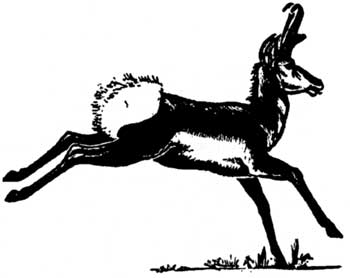
A loping pronghorn antelope. Note the spread rump patch “rosette”.
Briggs in Einarsen, p. 47.
Other pages in this section


